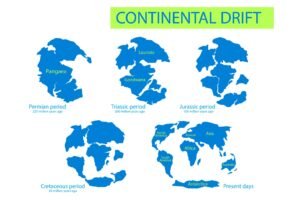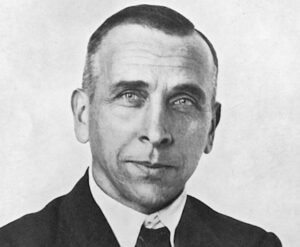CONTINENTAL DRIFT THEORY: REVISITING ALFRED WEGENER'S REVOLUTIONARY THEORY
- Related toPhysical Geography
- Published on9 June 2025
 Have you ever looked at a world map and noticed how the eastern coastline of South America seems to nestle perfectly into the western coast of Africa, almost like pieces of a giant jigsaw puzzle? This isn’t just a coincidence. It’s a clue to a revolutionary idea that, a century ago, turned the world of geology upside down.
Have you ever looked at a world map and noticed how the eastern coastline of South America seems to nestle perfectly into the western coast of Africa, almost like pieces of a giant jigsaw puzzle? This isn’t just a coincidence. It’s a clue to a revolutionary idea that, a century ago, turned the world of geology upside down.
This is the story of the Continental Drift Theory, a concept proposed by a German meteorologist named Alfred Wegener. He suggested that our continents are not fixed but are constantly, albeit slowly, wandering across the face of the Earth.
While his ideas were initially met with ridicule, they laid the foundation for our modern understanding of the dynamic planet we live on. So, let’s journey back in time and explore this groundbreaking theory.
The Grand Idea: A World Once United
In the early 1920s, Alfred Wegener put forth a bold hypothesis. He proposed that about 300 million years ago, all of the Earth’s continents were joined together in a single, colossal supercontinent. He named this landmass Pangaea, meaning “all lands” in Greek. This supercontinent was surrounded by a single, vast ocean called Panthalassa, or “all seas”.
According to Wegener, Pangaea was not a permanent fixture. He suggested that it was split by a long, shallow sea called the Tethys Sea, which separated it into two smaller supercontinents: Laurasia to the north and Gondwanaland to the south. Then, around 200 million years ago, during the Mesozoic Era, these landmasses began to break apart and drift away from each other, eventually forming the continents as we know them today.
The Driving Force: What Powered the Drift?
One of the most challenging questions for Wegener was to explain what force could possibly be powerful enough to move entire continents in his Continental Drift Theory. He proposed two main mechanisms:
- Pole-fleeing Force: Wegener suggested that the Earth’s rotation creates a centrifugal force, which is strongest at the equator. He believed this force caused the continents to drift away from the poles and towards the equator.
- Tidal Force: He also theorized that the gravitational pull of the moon and the sun, which causes ocean tides, exerted a westward drag on the continents, causing them to drift.
While these ideas were creative, they would later become the theory’s biggest weakness. Modern science has shown that these forces are far too weak to move continents. However, Wegener’s attempt to provide a mechanism, however flawed, was a crucial step in the right direction.
The Trail of Clues: Evidence for The Continental Drift Theory
Wegener was not just a dreamer; he was a meticulous scientist who gathered a wealth of evidence from different fields to support his theory. Let’s look at some of the compelling clues he presented.
1. Jigsaw Fit of Continents
Example: Coastline of Brazil and West Africa
One of the most visual and striking pieces of evidence for continental drift is the jigsaw-like fit of continents across the Atlantic Ocean. If we observe the eastern coast of South America, particularly Brazil, and compare it with the western coast of Africa, especially regions around Ghana, the coastlines align remarkably well.
- This fit is not just a surface coincidence; studies of the continental shelves—submerged extensions of continents—show an even more precise match.
- This suggests that these landmasses were once connected and later drifted apart due to tectonic movements.
Scientific Insight:
This observation served as one of Wegener’s earliest proofs, demonstrating that continents were not fixed but mobile over geological time scales.
2. Geological Evidence: Rock Types and Mountain Systems
Example: The Gondwana Sedimentary System
Another strong pillar supporting the theory lies in the continuity of rock formations across continents. The Gondwana system of sediments, which refers to geological layers laid down during the time of the ancient supercontinent Gondwanaland, is found across multiple present-day landmasses.
- India, South America (Brazil & Argentina), Africa (South Africa & Ghana), Australia, Antarctica, and Madagascar all exhibit matching sequences of Permo-Carboniferous glacial sediments.
- These rocks not only share similar mineral compositions but also reflect identical geological histories, such as glaciation events and the presence of specific fossils.
Scientific Insight:
Such identical geological patterns across continents that are now separated by vast oceans strongly point toward a common origin and later drift.
3. Paleontological Evidence: Fossils of Identical Species
Example: Mesosaurus and Glossopteris Fossils
Fossil records provide compelling evidence of past continental connectivity. For instance:
- Fossils of Mesosaurus, a small freshwater reptile, are found in both South America and Southern Africa, but nowhere else in the world. The reptile was not capable of swimming across oceans, implying the continents were once joined.
- Similarly, fossils of the ancient fern Glossopteris are widely found across India, South America, Africa, Antarctica, and Australia, reinforcing the idea of a shared landmass during the plant’s existence.
Scientific Insight:
These fossil distributions are difficult to explain unless the continents were once connected, allowing species to thrive across them.
4. Mineral and Natural Resource Distribution
Example: Gold Deposits in Brazil and Ghana
Another intriguing line of evidence is the occurrence of similar mineral resources in regions now separated by oceans.
- The gold-bearing rocks of Ghana (in West Africa) and Brazil (in South America) are geologically identical, in terms of both age and composition.
- These gold-rich formations formed under the same environmental conditions and time period when the two regions were part of the same continental block.
Scientific Insight:
This geochemical resemblance supports the theory that South America and Africa were once connected, forming a contiguous mineral-rich belt.
5. Paleoclimatic Evidence
Example: Glacial Deposits in Tropical Regions
Continental drift also explains ancient climatic anomalies. Rocks in India, South America, South Africa, and Australia show signs of glaciation, despite these regions now lying in warm tropical zones.
- The presence of glacial striations and tillite deposits from the Permo-Carboniferous period suggests that these continents were once located closer to the South Pole.
- Only after drifting to their present positions did they acquire tropical climates.
Scientific Insight:
Such climatic evidence indicates large-scale continental movement, which shifted landmasses across climatic zones over millions of years.
6. Biological Continuity and Endemism
Example: Similar Plant and Animal Species across Southern Continents
Besides fossils, the distribution of some living species also supports past continental connectivity.
- Certain earthworm and freshwater snail species are common in India, Africa, and South America, despite vast geographical separation.
- Flightless birds like ostriches (Africa), rheas (South America), and emus (Australia) have striking similarities, hinting at a common ancestor when these continents were part of Gondwanaland.
Scientific Insight:
Endemic species evolution in different regions with shared ancestry highlights how drifting continents led to biodiversity divergence.
7. Tectonic Fit and Mid-Atlantic Ridge
Example: Seafloor Spreading in the Atlantic Ocean
Later discoveries, such as the Mid-Atlantic Ridge, provided dynamic proof for continental drift.
- This underwater mountain range shows evidence of seafloor spreading, where magma rises from beneath the Earth’s crust and pushes the plates apart.
The symmetrical pattern of magnetic minerals on either side of the ridge suggests a steady creation of new ocean floor, gradually moving South America and Africa apart.
Scientific Insight:
Though discovered after Wegener’s death, this tectonic activity offered the mechanism his theory lacked—explaining how continents drift.
The Great Debate: Criticisms and Drawbacks to the Continental Drift Theory
Despite the compelling evidence, Wegener’s theory was met with widespread skepticism and criticism from the scientific community of his time. The main objections were:
- The Inadequate Mechanism: The forces that Wegener proposed—pole-fleeing force and tidal force—were proven to be insufficient to move continents. This was the most significant flaw in his theory.
- The Nature of the Crust: Wegener envisioned the continents as rafts of solid rock plowing through the softer rock of the ocean floor. Geologists of the time argued, correctly, that this was physically impossible.
- Selective Evidence: Critics pointed out that Wegener seemed to be picking and choosing evidence that fit his theory while ignoring data that contradicted it.
- The Timing of the Drift: Wegener could not explain why the drift began only in the Mesozoic Era and not before.
For these reasons, the Continental Drift Theory was largely dismissed for several decades.
 From Ridicule to Revolution: The Modern Perspective
From Ridicule to Revolution: The Modern Perspective
So, where does Wegener’s theory stand today? While the mechanism he proposed was incorrect, his fundamental idea of moving continents was spectacularly right. In the mid-20th century, new technologies and discoveries, particularly in the field of oceanography, led to the development of the theory of Plate Tectonics.
Plate Tectonics is the modern successor to Continental Drift. It explains that the Earth’s outer layer, the lithosphere, is broken into several large plates that are constantly moving. These plates carry the continents and the ocean floor with them, driven by powerful convection currents in the Earth’s mantle.
Plate Tectonics provides the powerful mechanism that Wegener’s theory was missing and explains the observations he made. It confirms the existence of Pangaea and provides a robust framework for understanding a wide range of geological phenomena, from earthquakes and volcanoes to the formation of mountain ranges.
The Legacy of Alfred Wegener
Although his theory was initially rejected, Alfred Wegener is now regarded as a visionary scientist.
He was a revolutionary thinker who dared to challenge the established scientific consensus of his time. Alfred Wegener (1880–1930) was a German meteorologist and geophysicist best known for proposing the Continental Drift Theory, which challenged the prevailing belief that continents were fixed. In 1912, he suggested that all continents were once part of a single supercontinent called Pangaea, which gradually broke apart, with the fragments drifting to their present positions. Wegener supported his theory using evidence such as the jigsaw-like fit of continental coastlines (especially South America and Africa), the presence of identical fossils across oceans, similarities in rock formations, and signs of past glaciation in now-tropical regions. However, he could not explain the mechanism behind this movement, and his idea was initially rejected by the scientific community. It was only decades later, with the discovery of seafloor spreading and the development of plate tectonic theory, that Wegener’s ideas gained acceptance. Though he died during an expedition to Greenland in 1930, Wegener is now recognized as a visionary who revolutionized our understanding of Earth’s geological history.
Core Idea: Continents were once a single landmass called Pangaea, surrounded by an ocean named Panthalassa.
Break-up: Pangaea split into Laurasia (north) and Gondwanaland (south), which then drifted to their current positions.
Wegener’s Evidence:
- Jigsaw Fit: The coastlines of South America and Africa fit together.
- Geological Match: Similar mountain ranges (Appalachians in North America, Caledonians in Europe).
- Fossil Distribution:
- Mesosaurus (freshwater reptile) in Brazil and South Africa.
- Lystrosaurus (land reptile) in India, Africa, and Antarctica.
- Glossopteris (fern) across southern continents.
- Ancient Climates: Glacial deposits (tillite) in tropical regions and coal in cold regions.
- Placer Deposits: Gold deposits in Ghana with source rocks in Brazil.
Proposed (but incorrect) Forces:
- Pole-fleeing Force: Earth’s rotation pushing continents toward the equator.
- Tidal Force: Gravitational pull of the moon and sun.
Main Criticism: The forces Wegener suggested were proven to be far too weak to move continents.
Modern View: The theory was revived by Plate Tectonics, which explains that continents move on large plates driven by convection currents in the Earth’s mantle.
Loved this article? Go to Learning EDGE+ Page↗️






